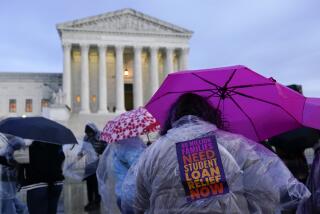SOCIAL PROGRAMS : GI Bill Marks 50 Years of Giving Vets a Shot at Their Dreams : It transformed the middle class and ideas about education. Today it is cited as a prototype for government initiatives.
- Share via
The GI Bill, one of the century’s most powerful legislative forces of social change, turns 50 today--still on the books and altering American lives even as a new generation of political leaders tries to capitalize on its success.
Signed into law on June 22, 1944, by President Franklin D. Roosevelt, the GI Bill of Rights transformed the United States during the tenuous post-World War II era, paying for the education of 7.8 million soldiers returning to civilian life. It opened up opportunities, providing professional careers to a generation born to working parents. And it reshaped American life, swelling the ranks of the middle class, expanding university campuses and making college education a goal for the masses as well as the elite.
The nation invested $7 billion in the GI Bill’s education programs from 1945 until 1952, but the return in productivity among those who used the bill’s education benefits pumped at least $35 billion--and perhaps as much as $84 billion--into the economy, according to an analysis by the Joint Economic Committee of Congress.
“It was one of the great transforming events of the last 50 years,” said Columbia University social historian Kenneth T. Jackson. “It opened up the doors of opportunity for an entire generation.”
President Clinton has described the GI Bill as his favorite government program, the defining example of the mode of broad-based social initiatives he favors. Clinton invokes the GI Bill repeatedly as he lobbies for his social agenda. He used it as a prototype for his national service program, passed last year by Congress.
“The GI Bill’s popularity has a lot to do with the gratitude of the American people for the service of the men and women who went to war, and this President has done an enormous amount to put the issue of service back on the front burner,” said William Galston, Clinton’s deputy assistant for domestic policy and one of the idea men behind the President’s national service program.
Yet despite the GI Bill’s lingering popularity, there is little consensus over whether it can--or should--serve as a model for peacetime legislation. Historians describe the GI Bill as a creature of its time, succeeding in an era when the nation’s middle class and its businesses were already poised for expansion.
“The problem is that the GI Bill was an engine of expansion--of the mind, of business, of society,” said Lehman College historian Davis Ross, an expert in the political origins of the bill. “Almost every segment of society benefited. All of the big social bills passed in the last 20 years go in the other direction. Everybody’s trying to save what they have.”
And Clinton’s political critics insist that the sort of unanimity he seeks for his own broad-based programs could never be achieved outside of a wartime setting.
“When you use GI Bill rhetoric to sell your own flawed political program, you cheapen what the GI Bill did for this country,” said Doug Bandow, a senior fellow with the libertarian Cato Institute.
GI Bills were passed during the Korean and Vietnam wars but used by successively smaller waves of students. Former GIs now can receive up to $5,000 a year in tuition--a far cry from the 1944 bill, which paid all tuition and a $75 monthly stipend at any school in the country.
Through the early 1950s, many of the nation’s college campuses swelled with a generation of GI students who took advantage of the bill’s benefits. Quonset huts sprouted around Memphis State University as homes for the families of young GIs. Veterans studied in warehouses at the University of Illinois’s temporary pier on Lake Michigan.
The bill changed the nation’s attitudes about education. No more than 40% of the returning vets would have gone to college without the GI Bill, the Joint Economic Committee study concluded.
“Hundreds of thousands of working-class kids had access to college for the first time,” said Northwestern University military sociologist Charles Moskos. “They in turn have passed on those attitudes to their kids.”
The bill grew out of a bitter two-decade battle over pensions that veterans of World War I’s American Expeditionary Force insisted they were promised by the country’s political leaders.
World War I veterans marched on Washington in 1932 seeking their economic due. Dispersed by Army regulars during a bloody clash on the banks of the Potomac, many remained embittered by their treatment. Vowing they would not allow a repeat of those events, veterans’ groups began lobbying after 1942 for a benefits package for those returning from service in World War II.
At the same time, F.D.R. Administration officials began post-war planning, fearing that if the American economy was forced to absorb millions of returning soldiers all at once, the nation would plunge back into a financial depression--as almost occurred after World War I.
Only as the war ground on and veterans’ groups made a reward for returning GIs a priority did it become obvious that the GI Bill “was a no-lose proposition,” Jackson said.
Yet even the framers of the bill had no idea of its ultimate impact. No more than 600,000 returning soldiers were expected to use the education benefits. And few GIs were even aware at first of the broadening influence of the bill.
Robert A. Eubanks, a warrant officer who served in an all-black port unit in the Pacific theater, only heard about the benefits from a superior as he mustered out in 1946--two years after the bill’s passage. “It was news to most of us,” said Eubanks, now emeritus professor of civil engineering at Illinois State University.
“It really wasn’t until I was accepted at (the Illinois Institute of Technology) that I realized what was going on,” said Eubanks, a Chicago orphan who used his degree to carve out a career in engineering. “The place was crawling with soldiers, all impatient to get a degree and get on with their lives.”
Some critics of Clinton’s efforts to fashion a broad-based social agenda say that the GI Bill’s overwhelming success--despite its more modest goals--serves as a warning that activist government programs do not always turn out as they are intended.
Bandow and other critics are especially wary of Clinton’s national service program, which aims to reward 100,000 students who work in community service jobs with two-year college tuition awards of up to $4,725 and health-care and child-care benefits. The program, hailed by some as a modern version of the GI Bill, does not approach the older bill either in scope or purpose, critics claim.
“The GI Bill rewarded millions of servicemen, no matter who they were or where they came from, for their risks during the war,” said Allison Tucker, who analyzed Clinton’s plan for the conservative Heritage Foundation. “Clinton’s plan, on the other hand, is a make-work program for privileged kids.”
The reality is not so stark.
Many college campuses in the late 1940s and 1950s “were still segregated or limited their populations with quotas,” Jackson said. That was evident to Eubanks, who saw few other blacks on his own campus during the late 1940s.
And despite complaints that it helps those who already have access to college, Clinton’s service program was designed explicitly to be broad-based and not aimed at helping only poor Americans.
“The GI Bill can be duplicated in a peacetime setting as long as you don’t limit it to only certain groups,” said James H. Scheuer, a former congressman who now serves as Clinton’s ambassador to the European Bank for Reconstruction and Development.
Scheuer, who used the GI Bill to finance his pursuit of a law degree at Columbia University, could have afforded his degree anyway. But the GI Bill’s success, he said, came from its availability to every service member.
“It’s time we moved away from programs that help only narrow segments of society,” Scheuer said. “The idea of giving something back to Americans who are willing to serve society is one we need to boost--no matter who they are or where they come from.”
Was It a Good Investment?
The GI Bill of Rights increased incomes and spurred economic output, according to a study of World War II veterans. The study, by the Joint Economic Committee of Congress, spanned 1952 to 1987, the estimated working times of most WWII veterans.
ABOUT THE GI BILL
* 2.2 million veterans: Received college or graduate education under the GI Bill.
* $19,000: Estimated extra annual earnings for those who attended college on the bill.
Where they trained College: 29% Farm trainee: 8% On-job trainee: 18% Other schools: 45% Participation among vets GI Bill users: 7.8 million Non-users: 7.6 million Total difference in income between those who used GI Bill and vets who did not go on to college. (in billions) 1952: 0.9 1957: 1.9 1962: 2.7 1967: 5.8 1972: 6.8 1977: 6.2 1982: 4.0 1987: 4.5 Sources: Library of Congress, Joint Economic Committee of Congress
More to Read
Sign up for Essential California
The most important California stories and recommendations in your inbox every morning.
You may occasionally receive promotional content from the Los Angeles Times.












